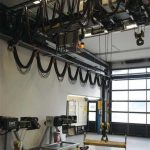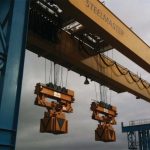Overhead cranes may seem simple to operate, but mistakes and accidents can happen. Julian Champkin looks at training for operators.  
Hoists, overhead cranes, gantry cranes: call them what you will, they are in almost every factory and processing plant, sometimes by the dozen. They seem simple in concept, which they are; and correspondingly simple to operate, which is true only up to a point. “There is more to it than just picking up a load and moving it,” says Larry Kime, subject matter expert from the US-based training provider Crane Inspection & Certification Bureau (CICB). “People think all there is to operating an overhead crane is up, down, sideways and stop,” says Paul Mackley, industrial training unit manager at Didac, a UK training company. But it is not just the controls: it is the weight behind it, the load, and the way that the load behaves. And they can be as small as a handoperated chain hoist, and as big as an overhead gantry crane on 25ft rails moving massive containers off railway wagons that the operator can only see through the glass floor of the cab he is sitting in that is mounted 85ft up in the air. “We took over a job like that recently,” says Mackley. “The previous trainer, from another company, had had a panic attack and left, it was so high.” Even on small hoists there is a lot that can go wrong; and the accident statistics for overhead cranes are surprisingly high. “It is not a massively difficult piece of equipment, but a crane is no less dangerous than any other machine in hands of an unskilled operator.” Which is why, he says, everyone needs training. Many companies, on both sides of the Atlantic, offer training courses for overhead crane operators; and the demand for them is surprisingly high, and consistent. “Overhead is big for us,” says Jonah Hobson of Industrial Training International (ITI). Larry Kime at CICB says: “What most people don’t know is that much more of our training is for operators and riggers on overhead cranes than on construction cranes.“ There are reasons for both halves of that statement. Construction cranes are highly visible, seen on every building site. Hoists are inside warehouses and plants; the public hardly see them. “But work out roughly how many overhead cranes there are,” he says. “One of our clients is a plant that makes locomotive engines in Pennsylvania. That plant alone has 3,000 overhead cranes and 5,000 people who operate them. And that is just one plant. Another of our clients employs 50,000 people, where they manufacture aircraft and the like. That makes for a huge number of overhead cranes. It way exceeds what everyone sees in the construction industry.” Even for managers, overhead crane operators can be invisible. Again, there is a reason: in many, perhaps in most, plants that use such cranes, the job title of ‘overhead crane operator’ does not exist. “A big trend we see is that the industry is not realising that a crane is one tool among many,” says Kime, “and using it is a specific application of a tool. It assists a craftsman to do his or her job; but that craftsman is primarily a millwright, or an engineer, or a machinist. He operates the crane, but for him the crane is also the tool that lets him move the object into place and position for them to work on it and then move it on afterwards to make space for the next task. So the job description of ‘overhead crane operator’ is not a usual one, nor is it usual now for someone to do that job full-time. It is an adjunct to primary skills and tasks.” Nevertheless, training in using them is vital. Health and safety is one obvious reason; insurers requirements are another. “We have had numerous clients training with us because there has been a mistake or a near miss and they don’t want to see it happen again,” says Kime. Sheer economic common sense is a third motivation for employers. The value of the load being moved can frequently be immense. “Last week we went to a company that makes turbines, to give their operators a training course,” says Mackley. “They said, please do not use that load to practise on; it cost £1.2 million. Dropping it would have been catastrophic. Similarly, a world famous museum wanted to move a unique Mayan canoe over a gangway. The object was light, but priceless. Their contractors could not get insurance coverage to move it, so we trained the museum’s own staff.” “Another trend that we are seeing is that people are recognising that experience is not enough,” says Kime. “People need refresher courses every two to three years. It is not a regulatory requirement in the US, but the recognition is growing.” Other regulators around the world also often recommend refresher courses every few years. Overhead cranes may seem simple to operate, but mistakes and accidents can happen
| 
